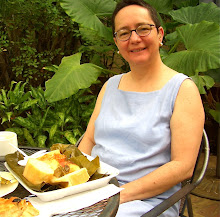
My mother learned the ancient and venerable art of "Ikebana" or Japanese flower arranging while in Japan from 1955-57, when our family moved there for my father, Cecil Uyehara, to pursue research supported by the Ford Foundation. Since that time, Mom has been studying and teaching Ikebana, and organizing chapters of Ikebana International (of which she is a charter member and officer) around the world.
In the arrangement above, she was demonstrating how to make an arrangement that emphasizes the container rather than the flowers. She worked with the colors of the container to coordinate the other elements of the arrangement, without overpowering the container.
 The arrangement to the left also uses a container by Nicaraguan artist Francisco Calero, and again the goal of the arrangement is to emphasize the beauty of the container.
The arrangement to the left also uses a container by Nicaraguan artist Francisco Calero, and again the goal of the arrangement is to emphasize the beauty of the container.Both of the containers created here by Sr. Calero draw on the past -- inspired by pre-Columbian and Southwest US Indian styles.
Both of these arrangements illustrate how links between cultures can create beauty that elevates both societies. It is interesting to note that Japan is very active in providing foreign aid to Nicaragua. Between 1975 and 2004, Nicaragua has received ¥413.6 in cultural aid alone from Japan (http://www.mofa.go.jp/region/latin/nicaragua/index.html). And maybe you have noticed the many sidewalk signs in various cities sporting a red circle on a white background next to trash cans, part of a project by Japan in Nicaragua to reduce trash on the streets.
 In addition a group of Japanese medical personnel volunteered published an extremely useful and beautiful book on primitivist artists and paintings (such as the one to the right) of Nicaragua. It provides a short history of primitivist art in Nicaragua, and then includes copies of hundreds of paintings by Nicaraguan artists. Nicaraguan artist Julie Aguirre and Padre Ernesto Cardenal were instrumental in collecting and contributing to this book.
In addition a group of Japanese medical personnel volunteered published an extremely useful and beautiful book on primitivist artists and paintings (such as the one to the right) of Nicaragua. It provides a short history of primitivist art in Nicaragua, and then includes copies of hundreds of paintings by Nicaraguan artists. Nicaraguan artist Julie Aguirre and Padre Ernesto Cardenal were instrumental in collecting and contributing to this book.

No comments:
Post a Comment